|
How My Train Jumped All 8 Tracks or Elvis Cool To Truck Stop Cruel
Program 1
by Keith Wright
Intro
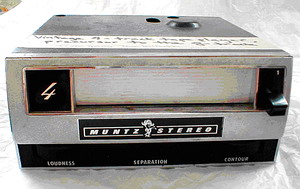
|
|
Early Muntz 4 Track "Stereo Pak"
car player—almost the first widely successful consumer tape format.
|
|
|
I am what I research, but I can change…….
if I have to…….I guess. Unfortunately,
I can’t really use that take on ‘The Man’s
Prayer’. I really WANT to change—but can’t.
Take 8-tracks…please. [insert rim shot] They
really have become an ‘ugly puppy’ of recording
history. So much so that I feel absolutely
compelled to admit to you that…I doubt I ever
touched a single cart until 1998. That was when
I took one on extended loan as an example of the
technology for a demo. That cart (slang for an 8-
track cartridge, for you fortunate to be ignorant of
that fact) belonged to my mother-in-law. [insert
your joke here] As usual, not content with being
able to just wave one and not to play one, I did
some research. Then I wanted to make sure I got
an ‘interesting player’ to demo. That led me on a
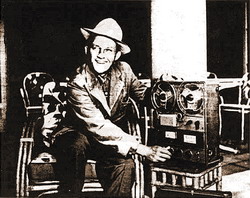
|
|
Bing Crosby with an Ampex version of Mullin's modified German Magnetphon.
|
|
|
merry chase through the lives of two…um…very
interesting men, into hardware solidly ‘of their
time’ while ‘just slightly ahead of their time’, and
to a cabal that have taken up the ‘infinite loop’
as a symbol for anti-commercialism. Just like an
8-track tape, pull
on it and this
story unravels
forever. And
after having
sneered at 8-
tracks during
their heyday
(and my youth)
I now find
their players
cluttering up
some shelves right under my…Edison
Home. Yowzah.
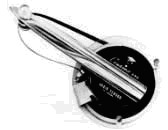
|
|
Cousino's endless loop "Audiovendor" for use on a standard tape machine (the tireless salesperson).
|
|
|
Much of the material I
present here was collected
as part of a presentation
I did for CAPS, under
a similar title, back in
2002. I guess Mike (APN
Editor) thought the statute
of limitations had expired.
Here to honour the infinite loop I structure my
offering to you in 4 programs—and continue to
use the conceit of the double-title.
Note that the CAPS constitution says: "An
antique will be defined as having an age of at
least 40 years." Since the start of the 8-track
era is generally defined as the time Ford offered
factory-installed players in its vehicles from the
1966 model year…
Now, I know you have that peculiar sound buried
in your head. Don’t fight it. Pretend we have
just pushed the cart gently into the player and it
has already reached the sensing-foil to change
programs. Here we go to program 1. Go ahead.
Listen to your mind…
|
Program 1
|
Program 2
|
Primal Ooze
or
Madman and Jet #1
|
Big Bang
or
Madman and Jet #2
|
|
Program 3
|
Program 4
|
Rise and Fall
or
Welcome To 8 Track Heaven
|
Noble Truths Of The Afterlife
or
‘Collecting’ Is A Dirty Word
|
[**Ka-chunk**]
Program 1—Primal Ooze
or Madman and Jet #1
[sound of program fading
in]…
The story of the
8 track’s
development is really
that of the development of
continuous, or infinite-loop,
magnetic tape. It surprised
me to learn that magnetic
recording was right there at
the birth of the phonograph
itself. This material can
be found in greater detail
elsewhere, but for our
purposes, here are some
quick highlights:
• 1878 (circa) mechanical
engineer, Oberlin Smith,
develops a theory of
magnetic recording after a
visit to Edison’s lab.
• 1888 The Electrical
World publishes Smith’s
"Some Possible Forms of
Phonograph" September 8.
In it, he describes a machine
using an electromagnet and
a string covered with iron
filings.
• 1898 Danish telephone
engineer Valdemar Poulsen patents the
Telegraphone—the ‘first working magnetic
recorder’. Demonstrated in Paris in 1900, it
looks like a tinfoil machine with wire wrapped
around the mandrel and a magnetic head instead
of a reproducer/recorder. Poulsen has possibly
used Smith’s work.
• 1928 a patent is granted to Fritz Pfleumer for
applying magnetic powder to film or paper strips.
(In 1936 the German National Court declares
that Pfleumer’s patent was covered in Poulsen’s
original patents of 1898
and 1899.)
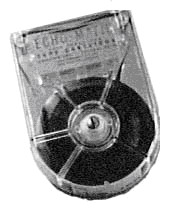
|
|
Cousino enclosed his endless loop in the "Echomatic" and the two-track cart is born. It was used in the head of a cow to sell dairy products. No bull.
|
|
|
• 1935 AEG unveils the
Magnetophon K1 using
tape made by what later
becomes BASF, under
Pfleumer’s patent. This
is the ‘first modern tape
machine’.
• 1936 Sir Thomas
Beecham conducts the
London Philharmonic in
the first public recording
using a Magnetophon.
• 1945 The Armour Research Foundation of
the Armour Institute of Technology invents an
improved wire recorder. (David Morton’s 1998
paper is subtitled, "How Academic Entrepreneurs
Fail".) William Powell Lear is a later Armour
licensee (watch this space).
B>• 1945 U.S. serviceman Jack Mullin ‘liberates’
Magnetphon technology—and 50 reels of BASF
tape.
• 1947 Bing Crosby asks Mullin to test record
his Philco Radio Time broadcast. The
result is a $50,000 investment in (A)lexander
(M). (P)oniatoff
(Ex)cellence to
commercialize Mullin’s
highly-modified
Magnetophons. 3M
earlier starts replacing
Mullin’s dwindling
supply of BASF tape.
(In 1946 the Ampex
boss had heard of
a demonstration of
Mullin’s machines and
began developing a
U.S.-made magnetic tape
recorder.)
• 1952 Bernard Cousino markets a
point-of-sale audio
device (non-tiring
salesperson?) using
an endless loop
tape system, the
"Audiovendor".
Cousino includes
double-coated tape to
reduce static build-up
in a ‘cart’ used on
an ordinary open-reel machine. Later he creates
an enclosed cartridge called the "Echomatic".
The two-track cart is born. (One source says the
point-of-sale device was put inside a cow’s head
for a dairy company promotion.)
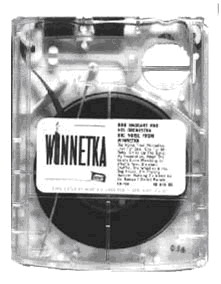
|
Eash's "Fidelipac" was used on radio into the 1990s. The Muntz "Stereo Pak" would find another use for it. Courtesy of wgeneration.com
|
|
|
• 1959 after sharing space with Cousino, George
Eash produces what becomes the ‘broadcast
industry standard’ endless-loop audio tape
cartridge, the "Fidelipac". Eash cannily licenses
his design—it will be used until the late 1990s
and is on the direct path to the first popular
consumer tape format. It is standard 2-track tape
run at standard speed in an endless loop cartridge
that is ‘shoved’ into place when needed.
The other main application of Eash’s work was
done by a Madman.
Earl W. Muntz is one of the main reasons
why this subject is so much fun. He was a
high school drop-out, a self-taught electrical
engineer, and has been called "the master used
car salesman of all time." He is ‘credited’
(ahem) with starting the "I’m so insane, come
take advantage of my crazy prices" school of
advertising that continues to this very day. We
need to have fun with Earl here, but we also
need to track three things: his salesmanship, his
interest in cars and his interest in electronics.
As for salesmanship, the Department of
Advertising, The University of Texas at Austin
has the following slogans listed as ‘interesting’:
"I can’t believe I ate the whole thing!" - Alka-Seltzer
"The Greatest Show on Earth." - Barnum & Bailey Circus
"I wanna give ‘em away but Mrs. Muntz won’t let me. She’s crazy." - Madman Muntz, used-car dealer (1946)
"I dreamed I stopped traffic in my Maidenform bra." - Maidenform
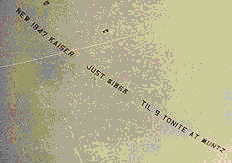
|
|
Part of a photograph showing Muntz' marketing skills in action-a tow-plane selling cars.
|
|
|
"Muntz, born in Elgin, Ill., was 20 when he
started his used-car business there. Seven years
later he opened a lot in Los Angeles. As a
speculation, he bought 13 new, war-stranded,
right-hand-drive cars which had been built for the
Orient, including a custom-built Lincoln intended
for Chiang Kaishek. When Los Angeles papers
ran stories about the cars, Muntz sold the entire
lot in two weeks without even unpacking all the
crates, making a tidy profit.
"He decided to stake his whole profit on
promotion, turned himself into the Madman.
His billboards, with their mad legends and his
singing commercials made his name a California
gag. Red Skelton, Bing Crosby and others kidded
his commercials, the University of Southern
California rooting section spelled out his name
at halftime, and soldiers at Santa Ana Camp
marched into chow singing "MUNTZ, that’s
Muntz." And his gross jumped from $150,000 to
$1,000,000 a month.
"… "Madman" Muntz’s zany advertising,
depicting himself as a
lunatic in a Napoleon hat
("I buy ‘em retail, sell
‘em wholesale. More fun
that way!") … made him
the used-car king of Los
Angeles." (‘Dig That
Crazy Man’, Time, July
13 1953)
So, we can see his
Salesmanship. Now we turn to electronics.
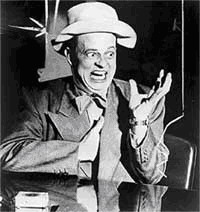
|
|
Madman Muntz in full form.
|
|
|
In 1946 Muntz turned
to the idea of selling
televisions. A self-taught
radio engineer (one story
has him building a radio
at age 8), he came up
with the idea of creating
receivers that would be
very inexpensive, very
simple, and would still
work satisfactory in urban
areas. Additionally, low
costs equate to low prices
and high sales volume
which leads to still further
economy of scale in
manufacturing—and to another fortune for the
"Madman".
"…Earl ("Madman") Muntz, onetime used-car
magnate turned television tycoon, showed further
evidence of his advertising talent by announcing
that he would christen his baby daughter Tee Vee
Muntz." - Time Feb. 18, 1952 [she would later go
by ‘Tina’]
"In Chicago, a center of the U.S. television
industry, old hands catalogued brash, upstart
young Earl W. (for William) Muntz as merely
another California screwball when he invaded
their city and their business four years ago…they
assumed that the tough TV business would soon
drive him really crazy.
"The industry is not yet willing to grant that the
Madman, or his Muntz TV Inc., is here to stay,
but it has long since concluded that he is just as
mad a success in TV as he was in used cars. Last
year his TV company grossed $49.9 million…"
– Time, July 13, 1953
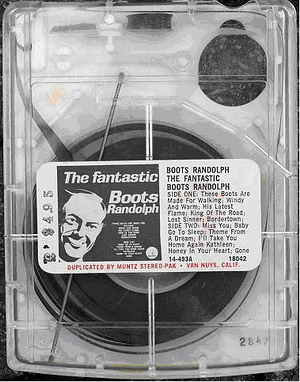
|
|
Muntz "Stereo Pak" cart-a "Fidelipac" preloaded with music. Clear plastic allows us to see the continuous loop of tape being pulled out of the centre and wrapping back around the outside.
|
|
|
"I remember Muntz TVs very well. I worked at
a TV shop in the 60s, when they were ‘popular’.
When I’d open the back of a Muntz TV, I’d be
amazed at how few components were inside.
"I also remember how unreliable they were and
how poorly they worked. ... "Mr. Muntz left
out all the shielding and bypass capacitors that
weren’t needed." - Tom, a TV repairman:
"His recognition that a crumby TV with only
2 IF stages instead of the typical 4 was good
enough for the 90% of the market that didn’t
live in fringe areas was pure genius. Let RCA
and Magnavox fight over the other 10%. We
had a Muntz TV that cost half what competition
charged, and it worked great in our area. But
Muntz was primarily a salesman. It doesn’t
matter how good a product is, if no one is buying
then it’s futile to design and build it. It doesn’t
matter how good Beta is when VHS has better
marketing. Too many of us take the Dilbert
attitude toward marketing and think that it is
somehow beneath us. But we have to sell our
products in the marketplace and our next project
idea to management. Remember Madman
Muntz, he’ll help you keep your feet on the
ground and make your career more rewarding."
- Engineer and past
owner of a Muntz TV
Muntz also practiced
a particular form of
design engineering
called "Muntzing".
Supposedly, Muntz
would review an
engineer’s electronic
circuit design and
suggest: "But, you
seem to be overengineering
this - I
don’t think you need
this capacitor." Muntz
would then cut out
the capacitor with
his wire cutters. If the picture was still
there, he would study
the schematics more
and continue to cut
out components.
Eventually, he would
cut out one component
too many and the
picture or the sound would stop working. Then
he would concede to the design engineer, "Well, I
guess you have to put that last part back in."
For a great article on "Muntzing", read ‘What’s
All This Muntzing Stuff, Anyhow?’ by engineer
Bob Pease in Electronic Design, July 23, 1992.
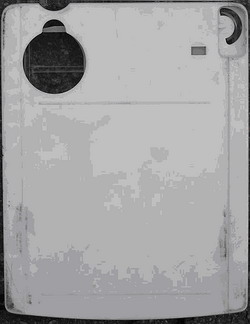
|
|
"Stereo Pak" rear to point out the large hole (top left). This is where the pinch roller from the player enters the cart to move the tape. It will be a key difference from the later 8-track-where it helped with the patents, but not with the longevity.
|
|
|
The huckster continued to work as Muntz
pioneered several modern conveniences. His
TVs had "Automatic Fine Tuning" - Muntz left
out the fine tuning knobs. This worked well
until the tuning drifted on a hot day. His TVs
had "Automatic Horizontal Hold" - Muntz left
out the hold circuits which weren’t necessary for
strong signals. His TVs were "Factory Tuned"
– Muntz’s production technicians would tune the
receiver to the local stations using "clip pots",
and then remove the pots and solder in a fixed
resistor. This very inexpensive manufacturing
method was great, but as the carbon resistors and
circuits aged, the TV would "go on the fritz."
Finally, Muntz’s TVs had larger screens - as
measured diagonally.
Muntz allegedly paid 400 disk jockeys to plug
Muntz TV on radio, printed slogans such as
"Stop Staring at Your Radio" on the backs of
Chicago streetcar transfers, and sold as many
as 4,500 sets in a single weekend. All were
destined to become repairperson heaven and
scarce collectors’ items.
"By 1949, Muntz was producing 5,000 TV sets
a month to keep up with sales. By 1950, he sold
$20 million in 72 stores nationwide. Muntz TV,
Inc., grew into a $55 million-a-year business.
"While repair men were happy to get all of the
repeat business tuning receivers on the fritz,
eventually Muntz’s customers figured out that
a low initial price was not necessarily the best
buy in the market." - Course ME491 Design
Methods, Portland State University, Portland,
Oregon, USA
You get the idea. So we now see the Madman’s
sales skills, his interest in cars and his interest in
electronics. We’ll put them all together after a
short diversion.
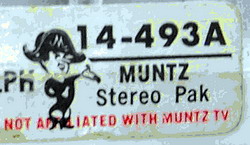
|
|
Disassociating from Muntz TV is a telling feature.
|
|
|
I haven’t been able to confirm, but it has been
suggested that Muntz was forced to sell his TV
business when a plan to sell a new performance
car failed in 1953-54. The "Muntz Jet" was
considered "…the first serious attempt in nearly
a generation to manufacture an American sport
car capable of measuring up to the top-flight
European jobs." Apparently building cars was
much different than selling them and, by his
own admission, Muntz lost about $1,000 a car.
Fortunately, he didn’t sell very many…no, wait.
By the way, Jets are also collectors’ items now.
According to ‘Troubled Times’ from Time,
March 15, 1954: "EARL ("Madman") Muntz,
who as late as January was talking about further
expansion of his TV-set business, has been
blacked out by creditors, who threw his company
into bankruptcy. Muntz admits that he is losing
money ($1,457,000 from April to August 1953),
but still thinks he can reorganize and stay in the
TV business." Earl,
of course, recovered
(he was to make 3
separate fortunes and
once remarked that he
never minded losing
a fortune because "it
was so damn much
fun making another
one") and somehow
got further interested
in consumer
electronics and the "Fidelipac" (remember that?) in particular.
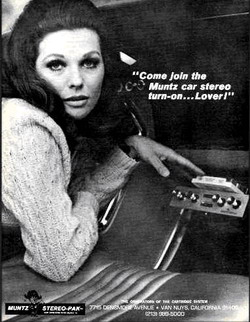
|
|
1969 "Stereo Pak" advert.
|
|
|
Sources say Muntz sold the TV business in
1962 (Pease suggests Muntz "realized he had
sold all of the cheap sets he could") to market
"Fidelipacs" under the label "Muntz Stereo
Pak". Inexpensive players were manufactured
in Japan and music was licensed from several
record companies for duplication on carts. But
the novelty here is that they were put into…cars.
Imagine, Earl and electronics and cars!
According to Bill Golden, an ex-employee,
"Muntz was able to license so many duplication
deals from record companies during the early
sixties at unbelievable prices because they (the
record companies) said that consumer tapes were
a passing fancy and that NOTHING would ever
replace vinyl records. So much for corporate
forecasters." Golden also mentions that he
worked with George Eash at Muntz. (from
Abigail Levine at 8trackheaven.com) One story
has it that Muntz put five "Stereo Pak" units into
his home—including one with speakers in his
swimming pool. He said, "It’s amazing how well
you can hear down there." (Writer John Lahr
earlier recounted a visit to the Muntz mansion
where there was a television at the bottom of the
pool…)
"The Madman also sent a buxom model,
renamed for the occasion- Brenda Muntz, to Viet
Nam to pass out "Stereo-Paks" to the GIs. The
Pentagon turned down his offer to put "Stereo-
Paks" in Jeeps."
From ‘A Tape for the Road’ in Time August 9,
1963: "The latest thing for your car is a built-in
tape recorder. The Beverly Hills are already full
of them—transistorized, chrome, four-speaker,
stereophonic cartridge models, activated by the
car battery. Frank Sinatra’s Riviera has one.
So have such clan wagons as Dean Martin’s
Corvette and Peter Lawford’s Ghia. Tape
recorders also make a sound like Muzak in
James Garner’s Jaguar, Red Skelton’s Rolls and
Lawrence Welk’s Dodge convertible.
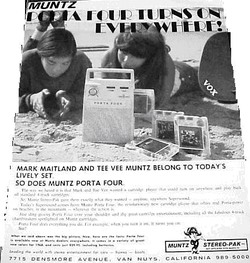
|
|
Tee Vee Muntz shilling for Dad's portable player.
|
|
|
"All are 12-volt
Autostereo models,
priced from $129 up,
made and distributed
in 14 states by
former Used-Car
Tycoon Earl "Mad
Man" Muntz of Los
Angeles. Designed
only for playback
with special
tape cartridges,
they take any
prerecorded material from the Muntz Music
Library. Senator Barry Goldwater bought one
from his son Mike, who holds the Phoenix
franchise. Comedian Jerry Lewis has cartridge
copies made of scripts, learns his lines by
Autostereo on the way to work. Sales have
reached epidemic proportions, claims a Muntz
spokesman."
From the ad copy for a 1968 Muntz home player
(below the picture of Tee Vee Muntz labeled
"today’s lively set") they claimed they had "over
100,000 titles featuring the greatest stars in
music. Today’s greatest sounding cars have been
stereoized [sic] by Muntz." Muntz must have put
"Muntzing" aside as in the noisy environment of
Sinatra’s car he moved into ‘hi fi’ by being an
early adopter of stereo standards. The stereo tape
heads he used put two stereo programs, a total
of 4 tracks, on a standard ¼ inch tape. There are
three US patents assigned to "Muntz Stereo-Pak"
from September, 1965 to June, 1966.
You’d think Muntz would be the salesman to
push this phenom across the US and eventually
around the world making the "Stereo Pak" the
world’s first popular consumer tape format. He
didn’t, and the 4-track was overtaken by another
format. Apropos of nothing at all, David Morton
claims that William Powell Lear became a
distributor for Muntz—mainly to install 4-track
units on his jets. One jet eventually shoots down the other?
But let’s not
get ahead of
ourselves.
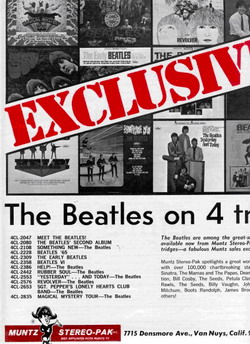
|
|
Yes, you read correctly-the Beatles exclusively on 4-track.
|
|
|
In 2001, Earl
was voted into
the Consumer
Electronics
Association
Hall Of Fame
along with
Emile Berliner!
Edison had been
voted in the
year before, with
Eldridge Johnson,
Vlademar
Poulsen, David Sarnoff and others.
"...speak of another time when the road and life
itself seemed more carefree—when Madman
Muntz in a crazy Napoleon’s hat smiled and
joked his way into our hearts and right on through
to our pocketbooks. Who cared if the gutlesswonder
TVs he sold weren’t the best? It was
the grin and the ad-man moxie we were really
buying."
Did I mention Earl Muntz was the developer of
the "Muntz Motor Mansion"? Or that he was
famous for having a TV in the dashboard of his
car to ‘help him concentrate’? Or that at the time
of his death in 1987 he was the top retailer in
L.A. for cellular phones? Or that someone just
made a movie about him? Or that he tried to
make air conditioners with glass-fiber cabinets?
Or his seven wives?…[sound fades out]
To be continued
Keith ("Crazy") Wright is CAPS Vice President.
|